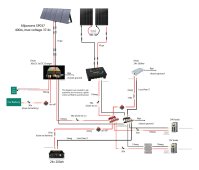This system is starting off in a minivan but may move to a larger vehicle or possibly even a piece of land. Once I have more space I'll invest in a lot of solar and likely add batteries. That may happen soon after I begin so I'd like something I can grow with.
While in the van I was considering bringing a rocket stove or some sort of camp stove with me. Not sure how practical that is though. Don't know how many city/state parks around the country would allow that. I do most of my cooking in crock pot now and I plan on using that in the van as well. I've watched a bunch of videos on their power draw, and many of the smaller ones are around 100w. I can use one for 7 hours and get 3 days' worth of food out of it (heating up the leftovers on propane). I have a Dometic CoolFreeze cf-25 and when I have the room, I'm getting a dc sunstar chest freezer (not in a minivan). I have an air fryer that I plan on using a couple times a week or as much as the system allows. I'm flexable with the air fryer and will only use it when I have the power to do so. I just want a system that can run a big draw like that efficiently, when I have the power to do so.
I've been working on a wiring diagram and compiling a list of everything I'll need over the past couple days, almost done. However, now I'm getting worried about a few things. First, I was planning on getting an eg4 server rack battery. However, since it'll be in a van with varying temps, dust, moisture and I'll likely be spending a lot of time around the coast, so salt. I'm wondering if an unsealed server rack battery is going to be a bad idea. With all the ports that means dust and moisture will likely be getting in it. I'm now leaning back towards a more common sealed lithium battery.
I'm sold on the kisae dmt2430 dc-dc charger / mppt. It allows you to set the amps it draws from car, so I'll likely keep it at 15-20a to not stress out the van too much. I'll also be installing a kill switch on positive from car battery so during short trips or stop and go, I can keep it off and still allow the kiase to charge using the mppt via the solar on the roof. Many days I'll be driving 6+ hours so I'll use it on days like that and if all works out it should give me plenty of power.
I found 2- 120w 24v solar panels that I'll put in parallel to the mppt. That's about as much as I can fit on the van and I'm hoping to get up to a 1000w a day out of them.
In addition to those two panels, I would like to get some folding panels, but it seems like most are suitable for 12v. I found two folding panels, each with 200w, that I was planning on putting in series. They have these specs: Open Circuit Voltage (Voc): 22.2V, Short Circuit Current (IOC): 12 A, Maximum Power Voltage (Vmp): 18 V, Maximum Power Current (Imp): 11A, Solar Energy Conversion Rate: 19%-22%.
I'm not sure how realistic that is though. Under normal conditions how tough will it be to keep the volts high enough to charge a 24v battery using two 200w folding panels? I read somewhere that about 25% shade or cloud coverage to them may reduce the voltage to a point where it won't be able to charge a 24v battery. Does that sound about right? If so, seems like a slim margin for error. Also, I imagine they'll degrade and likely produce less output in a few years, could that mean that they'll no longer be able to charge a 24v battery? I also came across 1 folding solar panel with 400w, max power of 10.6a, and max voltage of 37.4v but am also wondering, like with the two 200w folding panels in series, how difficult it will be to keep the volts high enough to charge a 24v battery?



